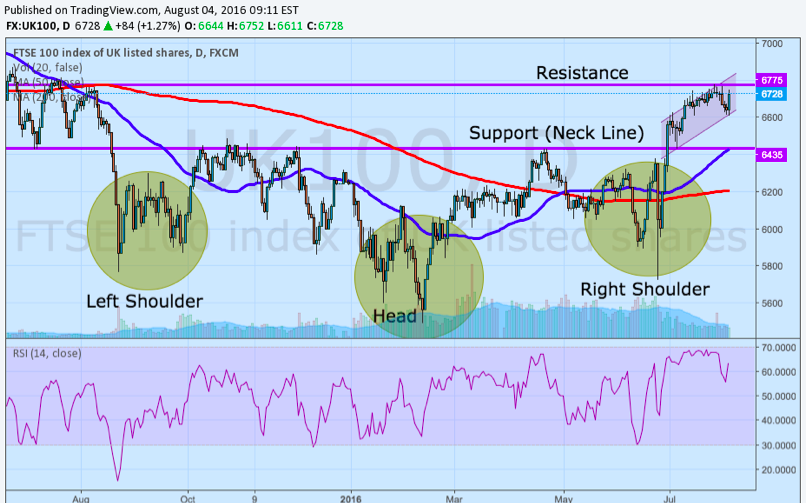With the Bank of England taking a super-dovish stance towards monetary policy, the immediate reaction outside of the Pound was a noticeable rally in the FTSE 100 equity benchmark. In response to an announcement that the Central Bank will restart purchases of government and corporate debt, equities surged to the upside amid expectations that the increased accommodation would spur demand for higher yielding assets like stocks. Furthermore, the rising probability of additional accommodation down the road has fed speculation that this is just the beginning of a new leg in the ongoing bull market after the index reversed from a bear market it fell into back in 2015. Although the global outlook remains subdued and the UK economy is forecast to experience significant growth deceleration heading into 2017, conditions are ripe for a sustained uptrend in the FTSE 100.
Accommodation Spells Upside
The sheer amount of evidence to support the relationship between central bank balance sheet expansion and the pricing of stock benchmarks has been growing since the wake of the last financial crisis, when the US Federal Reserve’s material support for the economy was unveiled. Balance sheet expansion that began in 2009 was closely mirrored by gains in the Dow Jones Industrial Average as evidenced by the chart below. The reason for the relationship is quite simple. As borrowing rates are pushed lower, investors normally reliant upon fixed income assets, see their returns markedly reduced, forcing them into riskier assets like stocks to make up for the shortfall. With interest rates at record lows, retirees and asset managers needing to show good performance were therefore channeled into the path of least resistance, in this case stocks.
While statisticians will be quick to point out that correlation does not mean causation, in the case of the direct relationship between quantitative easing and rising asset valuations, the proof is abundant. Even though the primary purpose of quantitative easing is to drop borrowing costs in an effort to stimulate lending and investment, in reality these activities tend to come secondary to hoarding capital and seeking higher yielding opportunities. Such has been the case across Europe and Japan since each respective Central Bank implemented and expanded their own asset purchase programs. Although designed to facilitate lending and growth, UK capital expenditures and R&D are likely to fall despite low interest rates. Moreover, now that Gilt yields have plunged to record lows, the obvious choice for investors hunting for yield will likely be the same path of least resistance, in this case being the FTSE 100.
Technically Speaking
After closing above key resistance at 6435 in the days that followed the EU referendum vote, the upside breakout capped off the earlier formation of a head & shoulders bearish pattern in the FTSE 100 that had been in the process of forming for the better part of 9-months. The move above the neckline at 6435 sent the benchmark bounding towards the next resistance level at 6775. While stocks were largely held back from appreciating on the basis of a strong Pound which reduced the appeal of UK stocks from a relative value standpoint, the wave of losses that have since ensued have added to their attractiveness. Helping to boost the bullish outlook for stocks are the moving averages which are currently trending below the price action, with both the 50-day and 200-day moving higher and acting as support for the index.
Aside from the bullish breakout, the emergence near-term of an equidistant channel formation is adding to the predominantly bullish bias in the FTSE 100. Even though the index’s price is currently trending near the middle of the range, in the event of another pullback, ideal bullish positions established near the lower channel line should conceivably target the upper channel line for an exit. The only level that stands in the way of further appreciation is resistance at 6775. However, there are some concerns that the FTSE 100 is approaching overbought territory. For one, the relative strength index is just shy of the 70.0 level that traditionally signifies the instrument as slightly overvalued. Moreover, falling trading volumes indicate that the current rally higher is based on weak buying pressure and not strong momentum, potentially setting the FTSE 100 up for a pullback towards support at 6435.
Looking Ahead
The key determinants for the how the FTSE 100 behaves over the coming weeks and months depends largely on how the revived asset purchase program performs and whether or not it is expanded.Additionally, outside of Central Bank balance sheet expansion, any sustained losses in the Pound will likely continue to support upside momentum in the FTSE 100. Upcoming employment data from the US alongside speculation that another rate hike is possible before the end of the year could catalyze a dollar rally that drives the GBPUSD pair even lower from current levels. Should this be complemented by expanded asset purchases, the FTSE 100 is likely to see buying pressure persist over the medium-term towards resistance at 6775.
Tradersdna is a leading digital and social media platform for traders and investors. Tradersdna offers premiere resources for trading and investing education, digital resources for personal finance, market analysis and free trading guides. More about TradersDNA Features: What Does It Take to Become an Aggressive Trader? | Everything You Need to Know About White Label Trading Software | Advantages of Automated Forex Trading











